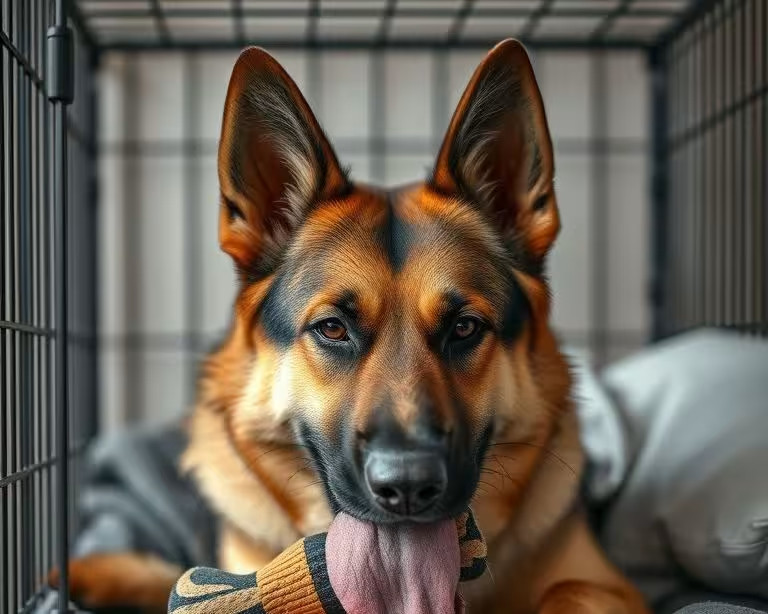Understanding and Overcoming Canine Separation Anxiety: An E-E-A-T Guide

Canine separation anxiety is far more than just a dog missing its owner; it's a profound behavioral disorder characterized by extreme distress when a dog is left alone. This condition can manifest in various ways, from mild whining to destructive outbursts and even self-harm, deeply impacting both the dog's well-being and the owner's peace of mind. As a complex issue rooted in deep emotional responses, understanding its nuances is crucial for effective management. This comprehensive guide, informed by expert insights and data-driven approaches, delves into the signs, causes, and multifaceted strategies to help your beloved companion overcome this challenging condition and thrive, even in your absence.
Recognizing the Signs of Canine Separation Anxiety
Identifying separation anxiety early is key to successful intervention. The signs can vary significantly in intensity, but they consistently point to a dog's inability to cope with solitude. Observing these behaviors can help pet parents distinguish genuine anxiety from mere boredom or mischievousness.
Destructive Behavior: More Than Just Naughty Paws
One of the most common and distressing manifestations of separation anxiety is destructive behavior. Anxious dogs often chew furniture, dig at carpets, tear up bedding, or destroy household items. Crucially, this destruction is frequently concentrated around doorways, windows, or other points of exit, reflecting the dog's desperate attempts to reunite with their absent guardians. This isn't out of spite, but a panic response, a frantic effort to escape the perceived threat of loneliness.
Excessive Vocalization: The Anxious Serenade
Whining, barking, howling, or yelping persistently while alone are hallmark indicators of distress. The duration and intensity of these vocalizations can serve as a direct gauge of the anxiety's severity. Unlike occasional alert barking, anxiety-driven vocalizations are often prolonged, frantic, and cease only upon the owner's return, or when the dog collapses from exhaustion.
House Soiling: Accidents Born of Distress
Even impeccably house-trained dogs may have accidents inside the house when suffering from separation anxiety. This isn't a lapse in training but a physiological response to overwhelming stress. The dog may be so stressed that they lose control of their bladder or bowels, indicating a severe emotional state rather than a willful act.
Self-Harm: A Cry for Help
In severe cases, dogs may resort to self-harm. Excessive licking, chewing, or biting at their paws, legs, or other body parts can lead to skin irritation, open wounds, and secondary infections. This is a critical symptom requiring immediate veterinary attention, as it signals profound psychological distress.

Escape Attempts: The Desperate Breakout
Dogs experiencing separation anxiety may go to extreme lengths to escape their confinement. This can include digging under fences, chewing through doors or window frames, or attempting to jump from windows. Such attempts often result in injury to the dog, damage to property, and highlight the intense panic they feel when left alone.
Pacing and Restlessness: The Pre-Departure Jitters
Before being left alone, or during periods of perceived isolation, a dog might exhibit signs of restlessness. This can involve incessant pacing, circling, or other repetitive, compulsive behaviors. This heightened state of agitation indicates anticipatory anxiety, a fear of the impending solitude.
Changes in Appetite: When Stress Affects Meals
Significant anxiety can disrupt a dog's normal eating habits. Some anxious dogs may refuse food entirely when left alone, even highly palatable treats. Others might eat excessively or develop abnormal eating patterns as a coping mechanism. Any sudden change in appetite coinciding with alone time warrants investigation.
Unraveling the Underlying Causes of Separation Anxiety in Dogs
While the exact origins of separation anxiety are complex and individual to each dog, several factors are commonly implicated. Understanding these underlying causes is fundamental to developing an effective management plan.
Early Separation Trauma: The Lingering Echoes of Loss
Puppies separated from their mothers or littermates too early (before 8 weeks of age) can be more vulnerable to developing separation anxiety later in life. This premature detachment can impede the development of coping mechanisms and emotional resilience. Proper socialization and a natural weaning process are therefore crucial foundational experiences.
Lack of Socialization: Building Blocks for Resilience
Insufficient exposure to various environments, people, sounds, and situations during the critical puppyhood socialization period (up to 16 weeks) can result in a dog who is generally more anxious and less adaptable to new circumstances, including being left alone. A well-socialized dog is better equipped to handle novel situations and periods of solitude.
Changes in Routine: The Instability Trigger
Dogs thrive on predictability. Sudden alterations in household routines, such as a new job schedule for the owner, a move to a new home, or the addition or loss of a family member (human or pet), can disrupt a dog's sense of security and trigger anxiety when left alone. These changes can remove familiar cues and support systems.
Previous Negative Experiences: Haunting Memories
Past negative events, particularly those involving abandonment, neglect, or abuse, can profoundly contribute to the development of separation anxiety. Dogs rescued from shelters or with unknown histories may carry these emotional scars, making them more prone to panic when their primary caregivers depart.
Breed Predisposition and Genetics: Nature's Influence
While not a definitive predictor, some breeds are anecdotally thought to be more prone to anxiety disorders, including separation anxiety. Similarly, a genetic component may play a role in an individual dog's susceptibility to anxiety. While environmental factors are paramount, an inherited predisposition can lower a dog's threshold for developing the condition.
Comprehensive Strategies for Effectively Managing Canine Separation Anxiety
Addressing separation anxiety requires a holistic and patient approach, integrating behavioral modification, environmental adjustments, and sometimes, veterinary support. Consistency is paramount for long-term success.
Gradual Desensitization and Counter-Conditioning: Rewiring the Brain
This cornerstone strategy involves systematically acclimating your dog to being alone. Start by performing pre-departure cues (grabbing keys, putting on shoes) without actually leaving. Then, leave for extremely short durations (seconds), gradually increasing the time as your dog remains calm. Counter-conditioning pairs alone time with highly positive experiences, such as a high-value, long-lasting chew toy or a puzzle feeder filled with their favorite treats. The goal is to change your dog's emotional response from panic to positive anticipation or calm acceptance.
Creating a Safe and Secure Space: A Haven for Solitude
Provide your dog with a comfortable, den-like space where they feel secure and protected. This could be a crate (properly introduced and never used for punishment), a cozy dog bed in a quiet corner, or even a specially designated, dog-proofed room. Make this space inviting with comfortable bedding, familiar toys, and an item carrying your scent. The safe space should be a place of calm and positive association, not confinement or punishment.

Environmental Enrichment: Beyond Basic Needs
A physically and mentally stimulated dog is generally less prone to anxiety. Ensure your dog receives adequate exercise tailored to their breed and age, engaging in interactive play that burns both physical and mental energy. Offer a variety of puzzle toys, snuffle mats, and treat-dispensing toys to keep them occupied and mentally engaged when you are away. A tired dog is often a calmer dog.
Consistent Routine: The Predictability Paradox
Maintaining a predictable daily routine significantly reduces anxiety by providing your dog with a sense of security and understanding of what to expect. Consistent feeding times, regular exercise schedules, predictable potty breaks, and consistent bedtime routines all contribute to a stable environment. A predictable routine minimizes uncertainty, a major driver of anxiety.
When to Consider Medication: Veterinary Guidance
In moderate to severe cases, behavioral modification alone may not be sufficient. Your veterinarian may recommend anti-anxiety medications to help manage your dog's symptoms. These medications are not a standalone solution but a valuable tool when used in conjunction with behavioral modification techniques, helping to reduce the dog's baseline anxiety levels so they can be more receptive to training. Always consult a veterinarian for diagnosis and prescription; never self-medicate.
The Role of Professional Help: Expert Intervention
For persistent or severe separation anxiety, consulting a certified professional dog trainer or a veterinary behaviorist is highly recommended. These experts can accurately assess your dog's specific needs, identify contributing factors, and develop a personalized, effective treatment plan. They provide invaluable guidance, support, and specialized techniques tailored to your dog's individual case.
Ignoring the Behavior: A Nuanced Approach
For very mild cases of whining or attention-seeking behaviors that are *not* rooted in true panic, it may sometimes be helpful to ignore the behavior. The idea is to remove the reward (your attention) from the anxiety response. However, this strategy must be implemented with extreme caution and only as part of a comprehensive behavioral program. Never ignore signs of severe distress or self-harm, as this can worsen the anxiety and potentially lead to injury.
Tools and Products to Aid in Separation Anxiety Management
Beyond training and environmental changes, several products can support your dog's journey to overcoming separation anxiety. These are aids, not cures, and work best as part of a comprehensive plan.
Calming Aids: Supporting Emotional Balance
- Pheromone Diffusers/Sprays: Products like Adaptil release synthetic canine appeasing pheromones, mimicking the natural pheromones a mother dog emits to calm her puppies. These can create a calming environment, particularly in your dog's safe space.
- Calming Chews/Supplements: Many veterinary-approved supplements contain ingredients like L-Theanine, L-Tryptophan, or Zylkene (a milk protein derivative) that promote relaxation without sedation. Effectiveness varies by individual dog.
Interactive Puzzle Toys and Lick Mats: Mental Engagement
- KONGs and Similar Stuffable Toys: When filled with treats, peanut butter, or specialized pastes and frozen, these can keep a dog engaged for extended periods, diverting their attention and associating alone time with positive rewards.
- Snuffle Mats and Treat-Dispensing Balls: These encourage natural foraging behavior, providing mental stimulation and a healthy distraction that can reduce anxiety.
Comfort Items: A Sense of Security
- ThunderShirts/Anxiety Wraps: These garments apply gentle, constant pressure, similar to swaddling an infant, which can have a calming effect on some dogs. They provide a sense of security and physical reassurance.
- Familiar Blankets/Clothing: Leaving an item with your scent in your dog's safe space can provide comfort and a reminder of your presence, reducing feelings of isolation.
Monitoring Devices: Owner Peace of Mind
- Pet Cameras (e.g., Furbo, Wyze Cam Pet): These allow you to remotely monitor your dog's behavior, offering insights into their anxiety levels and helping you to fine-tune your intervention strategies. Some even offer two-way audio or treat dispensing.
Crates and Safe Spaces: Structured Security
- Appropriate Crates: A properly sized and introduced crate can serve as a secure den for dogs who are comfortable with it, providing a sense of safety and limiting destructive behaviors to a contained area.
The Imperative of Patience and Consistency in Treatment
Overcoming canine separation anxiety is not an overnight fix; it's a journey that demands immense patience, unwavering consistency, and a deep commitment to a long-term strategy. Each dog progresses at their own pace, and setbacks are a normal part of the process. Celebrate every small success, whether it's an extra minute of calm alone time or a less frantic greeting upon your return. Remaining patient and supportive throughout this challenging period is crucial. Crucially, never punish your dog for exhibiting anxious behaviors. Punishment will only heighten their fear and anxiety, eroding trust and worsening the problem rather than resolving it.
Prevention is Key: Building a Resilient Dog from the Start
While management strategies are vital, prevention is always preferable. Proactive measures can significantly reduce the risk of separation anxiety developing:
- Early and Proper Socialization: Expose puppies to a wide range of positive experiences, people, and environments to build confidence and adaptability.
- Gradual Exposure to Being Alone: From a young age, teach your dog that being alone is normal and even enjoyable. Start with short durations and gradually increase, always ensuring positive associations.
- Consistent, Predictable Routine: Establish and maintain a daily routine for feeding, exercise, and potty breaks to create a sense of security and reduce uncertainty.
- Secure and Enriched Environment: Provide a comfortable, safe space and plenty of appropriate mental and physical enrichment to keep your dog content and engaged.
Frequently Asked Questions (FAQ) About Dog Separation Anxiety
What exactly is separation anxiety and how common is it?
Separation anxiety is a behavioral disorder where dogs exhibit extreme distress when left alone. It's characterized by a range of symptoms from vocalization to destruction. Studies estimate that between 14% and 50% of dogs suffer from some form of separation anxiety, making it one of the most common behavioral issues in canines.
Can my dog ever fully recover from separation anxiety?
While severe cases may require ongoing management, many dogs can significantly improve and even overcome separation anxiety with consistent, appropriate intervention. The goal is often to teach the dog to cope calmly when alone, reducing or eliminating anxious behaviors. Full 'recovery' means the dog is comfortable and relaxed in their owner's absence.
How long does it take to 'cure' separation anxiety?
There's no definitive timeline. It's a process, not a cure, and can take weeks, months, or even over a year, depending on the severity of the anxiety, the dog's personality, and the owner's consistency. Patience and a long-term perspective are essential.
What's the difference between separation anxiety and boredom?
Boredom can lead to destructive chewing or digging, but these behaviors are usually general and not specifically focused on exit points. A bored dog might also vocalize, but it's typically less frantic and more a call for attention. Separation anxiety involves genuine panic, physiological stress responses (panting, drooling), and behaviors exclusively triggered by the owner's absence, often escalating to frantic escape attempts or self-harm. Monitoring with a camera can help differentiate.
Should I get another dog to help with separation anxiety?
In most cases, getting another dog is not recommended for separation anxiety. The anxiety is typically focused on the absence of the primary human caregiver, not merely being alone. A second dog might even increase stress, as the anxious dog may transfer its anxiety to the new companion, or the new dog might learn anxious behaviors. Focus on addressing the core issue first.
Is crating good for dogs with separation anxiety?
For some dogs, a properly introduced and positively conditioned crate can be a safe, den-like haven that reduces anxiety. However, for dogs with severe anxiety or a history of crate aversion, crating can intensify panic and lead to self-injury if they attempt to escape. The crate should never be used as punishment and its suitability depends on the individual dog's comfort level and the severity of their anxiety. Always ensure the dog views the crate as a safe retreat, not a trap.
What are the best toys for a dog with separation anxiety?
The best toys are those that are long-lasting, mentally stimulating, and safe to be left unattended. Examples include durable puzzle toys (like KONGs stuffed with frozen treats), lick mats, and snuffle mats. These provide distraction, enrichment, and positive association with alone time. Avoid toys that can be easily destroyed or ingested, or toys that require human interaction.
Can diet affect separation anxiety?
While diet isn't a primary cause or cure, a balanced, high-quality diet is crucial for overall health and can indirectly impact a dog's emotional state. Some research suggests a gut-brain axis connection, where gut health can influence mood. Certain nutrients, like L-Tryptophan (a precursor to serotonin), omega-3 fatty acids, and specific vitamins, are sometimes included in calming supplements. Ensuring your dog's nutritional needs are met and consulting with your vet about specific dietary additions or calming formulas can be part of a holistic approach.

Conclusion
Canine separation anxiety is a distressing condition for both dogs and their human companions, but it is not an insurmountable challenge. By understanding its multifaceted signs and underlying causes, pet parents can embark on a journey of effective management. Through patient application of behavioral modification techniques, creation of a secure environment, judicious use of supportive products, and crucial collaboration with veterinary professionals, dogs suffering from separation anxiety can learn to cope, relax, and even enjoy their alone time. Remember, your commitment, consistency, and compassion are the most powerful tools in helping your canine friend achieve a happier, more peaceful life, whether you're by their side or temporarily away.

 By
By
No comments yet. Be the first!